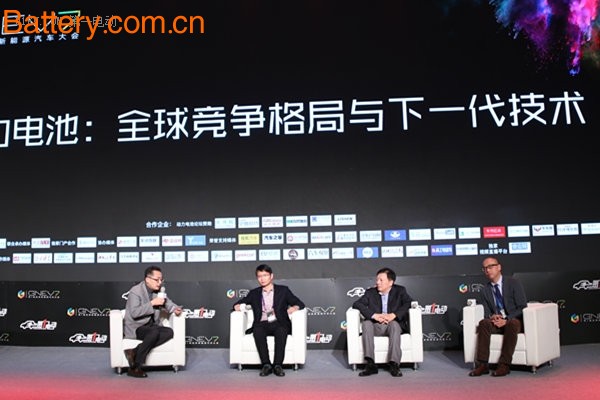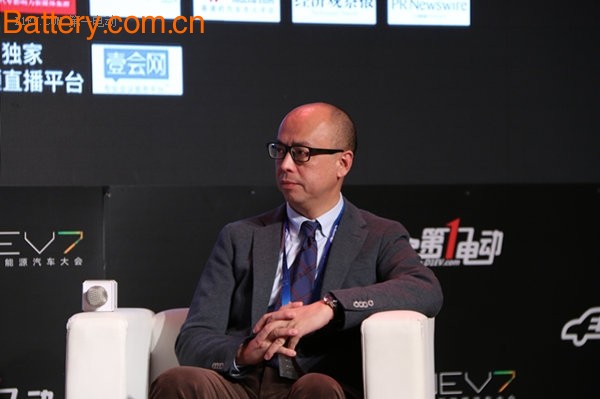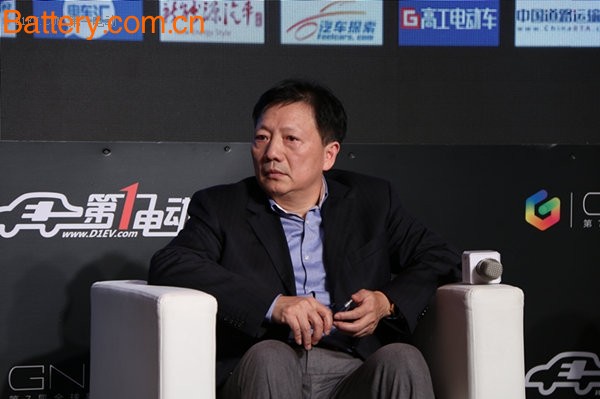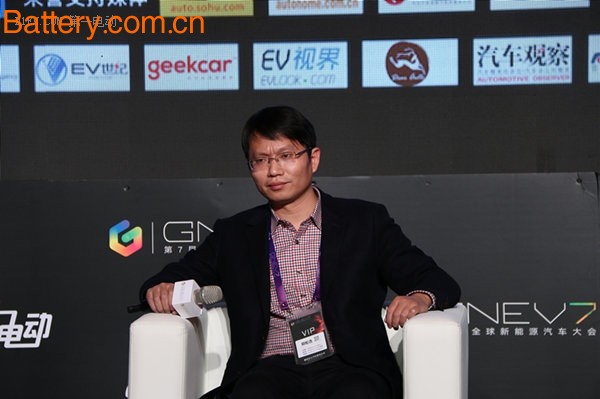On December 17, the 7th Global New Energy Vehicles Conference (GNEV7) opened at the China World Hotel in Beijing. In the afternoon, six sub-forums were held, one of which was about power batteries, with the theme of “Power Battery: Global Competitive Pattern and Next Generation Technologyâ€. In this sub-forum, Hong Bin from Dongfeng Nissan Qichen Business Unit, Liao Zhenbo, Vice President of BAK Battery, and Deng Lunhao, Vice President of Zhuoneng Power, participated in the discussion on the global competitive landscape and next-generation battery technology. Zhou Peng, CEO of Technology Co., Ltd., is the host of the salon. Zhou Peng (Moderator): Summarize the key words in the field of new energy vehicles in 2016. There are three key words for power battery: fraud, vehicle safety and geopolitics. I want to have five questions. These five questions basically ask different guests in the form of key words or numbers. The first question is about the 8 billion watt-hours proposed in the power battery industry normative draft, and companies that have to meet this capacity can enter the so-called power battery specification. I would like to ask Hong, what is the concept of 8 billion watt-hours? From the main engine factory, choose the battery supplier. If you can choose, what kind of choice do you have? What is your opinion on the cooperation between the OEM and the battery companies, from the coordination of me and open cooperation? Hong Bin: If the main engine factory chooses the power battery, it should be safety first, including battery consistency, vehicle safety, battery heating, and combustion. These problems may be great for new energy vehicles in the whole industry and for the development of electric vehicles. The impact, so our first consideration may be a safe and reliable performance; the second is mainly cost, the current cost of batteries accounts for about one-third to half of the cost of electric vehicles, I think The country gives so many subsidies. In fact, our understanding should be to replenish the power battery factory. We hope that we can have a certain scale for the whole vehicle. After a certain amount, its cost can be reduced. You just mentioned the scale of 8 billion watt-hours. Maybe because of this part of the battery, if it can't do a certain scale, its cost will not fall. Dong Bin, Deputy Minister of Dongfeng Nissan Kaichen Division Zhou Peng (Moderator): I can talk about it again. If the safety and cost are met, take Dongfeng Nissan as an example. Of course, the current supplier is definitely a Japanese supplier, then you will consider the domestic supplier? Or is it forced to consider domestic suppliers? Hong Bin: It must be an inevitable trend. Zhou Peng (Moderator): I want to ask Liao Zong the next question. From the perspective of competition, do you want to see that there are more than 10 factories in China that have reached 8 billion watt-hours? Because from our point of view, there are more than ten such capacity planning in China. I believe that there are still more batteries in Hong's car, so I would like to ask Liao, in this case, will the industry be the last? Take a strategy to warm up? Liao Zhenbo: BAK battery is the earliest power battery industry in the country. At present, it is also a well-deserved lead in domestic and international cylindrical battery. Just the host asked about the 8 billion watt-hour production capacity. In fact, I am still confused. I noticed The Ministry of Industry and Information Technology has put forward such a request for the scale of production capacity. I have also participated in some discussions. What is the purpose of this capacity scale? So what kind of cost is it to share? Our power battery is also divided into iron lithium batteries, our battery factory is divided into 3C polymer batteries. Bieke Battery Vice President Liao Zhenbo Our BAK battery is currently ranked first in the country in the field of ternary power battery. We have the most number of cars installed. How to prove that your product is qualified? If the product life cycle does not reach 5 years and 8 years, it is difficult to say that the battery itself is safe. I reported to you that in 2010, at the APEC meeting in Beijing, there were 200 Taipei cars that selected the power battery as a taxi. So far, these 200 cars have been on the market for 5 years. Running, it has a mileage of more than 170,000 kilometers per car. There is no safety incident. Bick has supplied hundreds of millions of batteries to the market so far, so there is no problem so far, so this is the safety Bic is well deserved. In terms of production capacity, BAK is 2.5 GW watt-hours this year. In 2020, it will reach 12G watt-hours to 14G watt-hour ternary batteries. The amount of our individual products is so large, in other words, from the inherent capacity. The requirement itself, to make a provision for production capacity, as a government department to stipulate, the original intention is to hope that we have economies of scale, just like car, talk about economies of scale, including the supply chain, including the network, including manufacturing, As well as the apportionment of research and development, so we said that the capacity regulations should be decomposed again, and then peeled off. We should not simply say the specific requirements for capacity, but just report this data to everyone, and Bick actually meets the national production capacity. Requirements. Zhou Peng (host): Mr. Deng, I think that your company has also been there many times. Are you going to 8GW when you are going to 8GW? Deng Lunhao: This question is quite tangled. On November 29th, there was also an industry association-led meeting in Beijing about 8G. The response was very intense at the time. Some companies were very excited. In reality, 8G瓦时, based on 40 kWh, is 200,000 vehicles. Corresponding to China, it is now possible to say that this year, that is, more than 400,000 vehicles. In other words, the two companies will be finished, then the origin of this 8G will actually be It is debatable, I think the state promotes it to have a certain scale effect, but also to support several large-scale enterprises. I want to raise its threshold on the one hand, and also take a market-oriented road on the other hand. Deng Lunhao, Vice President of Zhuoneng Power For Zhuoneng, Zhuo Neng should now say that the production capacity of the 18650 is still quite large. In Shenzhen, 700,000 units are built every day, and the new one is called 1 million. In fact, 700,000 production capacity per day has been completed. Compared with some enterprises, one of the best in China, from the capacity production, I said that it includes Guangxi and our Shenzhen two sectors. But we have calculated from 8G, to meet the daily output of 3.4 million 18650, very scary. So many listed companies, including even the 18,650 listed companies, add up, I think if they are all 8G watts, China has 10 million cars that are pure electric, now two companies can be satisfied, so I think this is from me personally. From a business perspective, I think this is open to question. Then Zhuoneng will develop moderately, and we will not bite the so-called 8G method. If necessary, the country will not warm up. Because the country is not clear, everyone can meet a certain capacity or conform to the concept of the country. Time relationship, I will first Speaking of which. Zhou Peng (Moderator): My second question is a key word. This key word is called power and responsibility. My question is specifically for Hong Zong. This year, I should say that there are two rights and responsibilities in electric vehicles. A very clear direction, the first is that the OEM should bear the ultimate responsibility for the safety of new energy vehicles . Even if the battery is responsible, the main engine factory is responsible. The second is the recovery of the power battery by the main engine factory. The main responsibility is to encourage the battery factory to do some cooperation. I would like to ask Hong Zong that in the case of these two full responsibilities, the main engine factory has two pots. How do you solve these two pots? How do you face this problem with downstream companies? Hong Bin: It was just a few representatives who were present at the time of publication. The earliest we can see that electric vehicles are mass-produced. The official mass production should be in 2013 and 2014, more specifically in 2014 and 2015. Many times before, the demonstration operation was carried out. The scale of mass production was really in 2014 and 2015. Generally, the entire life cycle of our design car is 5 to 6 years. Many car companies do not feel the way to deal with the batteries that I will retreat in the future. Or how, but this topic has always existed, and it is a very important topic. Just the host also said that the first one is the guarantee of a battery safety for the host factory, so this part is that we are choosing the battery supplier. At the time, it’s not just me that I’m just a choice, or if you reach me an indicator or a price, I will choose you. More often, I will participate in the development with the battery factory and the power battery factory to ensure safety. The second question, which cannot be avoided, has already begun to be introduced. It requires the OEM to monitor the battery during the entire life cycle. For the reuse or recycling of this part after the end of its life cycle, I can still introduce this part. Just one person mentioned that Nissan launched a brand new car in December 2010. It is almost five to six years this year, close to one of its life cycles, we are considering the part of battery recycling. It can be mentioned that the OEM and the outside company have a recycling company that is involved in the establishment of the power battery to do its recycling. The entire part of the company has also been in operation for three or four years. I believe such a kind of power battery. Recycling or recycling, including as a new method of household electricity storage, etc., I want to promote it in China soon, we also want to do more in this area to make some exploration and domestic Some cooperation of the company. Zhou Peng (host): My third question is still going back to a set of numbers. The two magic numbers are 90 watt-hours per kilogram and one is 120 watt-hours per kilogram. This is the legendary qualification. The energy density of the whole package of subsidy policy, I would like to ask Liao Zonghe and Deng Zong, in your existing products, the first time greater than 90 watts per kilogram should be no problem, from 120 watts per kilogram of package energy density now how far? Still achieved? Deng Lunhao: For this 90 watt hour per kilogram, 120 watt hour per kilogram, for the ternary system 90 watt hour per kilogram I believe that most enterprises have already achieved, this problem may affect the iron-lithium battery Big, so as far as I know, there seems to be some of the current large-scale special production of iron and lithium enterprises, and the output is controlled on this product. In view of the energy density of the whole package, now we do 18650 in the current market, we push about 200 watts per kilogram, and 220 watts per kilogram, the corresponding package is based on the existing technical conditions. About 60% of the time, meeting 120 watt hours per kilogram is actually achieved. Zhou Peng (host): So it can be said that even if you don't realize it is just around the corner. Deng Lunhao: Yes, I think it should not be a big technical problem. Liao Zhenbo: BAK's battery currently produces 18650. From the perspective of energy density, we have several series of energy density. There are 2.4 ampere hours and 2.75 ampere hours, which have reached 250 levels. Today's theme is our future technological development direction. From our battery companies, we still pay more attention to some of the batteries themselves, from the material system, now through high nickel, including silicon rich should reach 300, and then back Walking in the direction of metal lithium may have to make some changes in the material system. For now, the requirement from our cylindrical shape is very easy to achieve. Zhou Peng (host): After the two magical numbers, my next set of questions should be two sets of magical numbers. Of course, one is called 300 watt-hours per kilogram, and the other is called 350 watt-hours per kilogram. . I would like to ask Mr. Hong, 300 kWh per kilogram corresponds to a class A car, or A0 class car about 400 kilometers, such a car you think, for example, from the perspective of Dongfeng Nissan, in the market competition, such as Cheap 200 km car, what is your perception of this renewal mileage relative to battery and user experience, and user acceptance? Hong Bin: In fact, we often fell into a big bottleneck when we developed more electric vehicles. The higher the energy ratio of the power battery company, the higher the cruising range. The higher the energy ratio, or the longer the cruising range. Is it better to sell better, or is it better for this market? In fact, I personally feel that it is not necessarily proportional, why do you say that? For example, you just mentioned that the energy per 350 watts per kilogram is 400 kilometers faster than we can. I also mentioned how to travel when I spoke? When we promote electric vehicles, or when we come to do this new energy vehicle , we should give consumers more of a way of providing travel or a proposal. It is not that my electric car completely replaces a gasoline car. I think From Shanghai to Beijing, or from Shanghai to Changchun, to Harbin can not finish this thing, more likely to consider the travel solution, plus the country now, I think the country should be very clear This issue is also mentioned now. I saw two days before 2020. The development of our entire domestic charging station will reach 200,000. If we can do it within 1 km, there will be a charging pile to do fast charging. I think the 400km electric car is enough. Zhou Peng (Moderator): I think the next topic should be a key word. This key word is called “hollowingâ€, then China is a big country of lithium battery, but now the reality, let me give you an example, the high nickel positive electrode. The materials, including the maintenance of the diaphragm, including the steel that Deng always used as the outer casing of the battery, are still in the hands of foreign countries. Of course, I have also visited many battery factories. Many battery factories are very advanced and fully introduced. equipment. So the question I want to ask is, I would like to ask Deng to answer you first. That is to say, if everyone is doing a good job in this situation, it will eventually cause the entire battery industry to be very large, and there will be a hollowing out. The value chain moves further upstream. What should we do next? Deng Lunhao: From now on, capital is very concerned. There are so many rich people. As for the 18650 product, there are more and more companies that introduce foreign technology or foreign equipment, and many companies aiming at new energy vehicles. We have hired some high-end talents to join Korea and Japan. The original intention was to effectively enter this market, but objectively, capital also led to a large amount of overcapacity. This overcapacity is inevitably in a strange circle. Really have to solve this problem, our domestic equipment level is still lacking, and the technical level is also lacking. Therefore, when we can consider this problem, we have our own ideas, because each Enterprises must have their own core competitiveness in the development. This core competitiveness may be technology, some enterprises are equipped, but some enterprises may not be able to do all of our other operating modes. The products, all the equipment are completely imported, we are somewhat different in some points, and at the same time have their own understanding and understanding of this product, from this point to avoid homogenization, or the same approach. Zhou Peng (host): I want to ask Liao, for example, I have seen the production line of BAK now, it should be imported from abroad. Of course, I think your capacity planning will be relatively large in the future, in the core equipment and In terms of upstream core raw materials, because we have worked together on some projects, we have already felt deeply that we are subject to the control of upstream raw materials. What is Bic’s planning in this regard? Liao Zhenbo: The issue of industrial hollowing out should be an industrial basis of our country. This includes raw materials, including precision instrument manufacturing. This kind of industry is not in which industry or which part of the industry is responsible for product manufacturers. Or completed. Contrast, the reality is that the safety of the product is the first, and the quality is the first. Before I joined BAK, I was in another company. There are 104 in the world's top 500, and there are 20 billion investment, basically come to a point of view, 20 years responsible for investment, basically get a experience, is to ensure that the first product quality is equipment, and then management, if the equipment is not working, then you strengthen management Just to play a supporting role. So Bick, I have seen the past ten years of adhering to the view that equipment is in the first place, so he spent a lot of money to import Japanese equipment, so that its 18650 product consistency is very good, then the future A few years of investment, our capacity this year is 2.5G watt-hour ternary battery, next year will reach 6 G watts, next year's line has been invested, basically 100% is imported equipment, of course, we go down We are also very happy to see that the quality quality level of some domestic manufacturing equipment manufacturers is also improving. Then we will consider some domestic equipment in some of our equipment processes, which process is added to some domestically produced products. The equipment for passing customs. For the upstream industry, this piece is indeed a painful thing for our battery manufacturers. There is a strong pain point. When the battery is in large demand, the upstream raw material manufacturers, one is the high cost of price, the price increase is very powerful, at the same time Our downstream automakers need to reduce their cost requirements significantly. For example, we predict that by 2020, there will be a 50% drop in the cost of existing batteries, but how can the upstream cost be reduced? In addition, you see that our battery technology and material system are very important. It depends on the quality assurance of our raw materials. Therefore, we also hope that we can cooperate with upstream companies to overcome some material problems and make us A quality battery that provides better products for OEMs. Zhou Peng (Moderator): I want to pass these four questions. We should discuss the pattern. Of course, we have discussed the technology. Then I think the last question should still be practical. Just now, Chairman Li also When I talked about a dollar and a watt, from the perspective of industrialization, what is the expected value of the power plant in the OEM? These two battery companies don't ask too far, how much can you sell next year? Hong Bin: The goal is to make about 1 yuan in 2020, from 1 to 1.5. Zhou Peng (host): This is similar to the price we know about the European factory's 2020 target price, so I will ask Lao Deng first, how much do you want to sell next year? Deng Lunhao: I remember when I opened the sixth session in January this year, I proposed a concept, that is, at the end of 2016, it was 1 yuan per watt hour, and the system was 1.5 blocks per watt hour. Unfortunately, this year did not reach. This, I think more is the policy level to suppress the development of this industry. I think this is still valid. I think that next year, the goal that can be achieved this year may be extended by about half a year. I think that with the opening of this round of countries, in the middle of 2017 next year, the ternary system Will definitely go to 1 dollar a watt hour. Zhou Peng (Moderator): According to your question, I asked Liao, this question, you are currently a quasi-listed company, capital market, secondary market information is also more, if you really with Deng total 9 hair When the money is one watt, can the company's profitability be guaranteed? Liao Zhenbo: Hong Zong of the automobile factory and our power battery manufacturers have done a very hard work. He finally told us that it is to make 1 yuan, which means that our batteries are about 8 cents or less, 6 to 5 to 8 cents. Between this, I asked for a point two weeks ago with Mr. Dong Liang, the executive vice president of the China Automobile Association. I said that car manufacturers, including your association, require 300 watt hours, 350 watt hours, the same. Requires 2000, 3000 cycles of life, while requiring very good security, the cost is so low, and all your requirements are superimposed on the battery, do you know that this is contradictory? For example, when you want the energy density to come up, your cycle number will drop, and security will also cause some problems. Therefore, from a comprehensive point of view, I think it is more challenging for a dollar. Of course, we Customer is the supremacy, our customer is the car manufacturer, if the customer has such a demand, we are also working hard. We are very grateful for the capital market. We now see that the state subsidies should continue for another year or two. We want the automakers. Just now, Mr. Hong said that we are very understanding of our power battery, we can’t kill chickens and take eggs, so our profits are completely It is guaranteed. Hexagonal mesh is a wire mesh made of angular mesh (hexagonal) woven with metal wires. The diameter of the metal wire used varies according to the size of the hexagon. Breeding fence,farm fence,chicken farm fence,cattle farm fence Anping County Dongjie Wiremesh Products Co., Ltd. , https://www.dongjiewire.com



The metal wires are twisted into a hexagonal shape, and the wires on the edge of the outer frame can be made into single-sided, double-sided, or movable edge wires.
Hexagonal mesh has good flexibility and corrosion resistance and is widely used as gabion mesh to protect slopes.
According to different uses, hexagonal mesh can be divided into chicken wire mesh and slope protection mesh (or gabion mesh). The former has a smaller mesh, while the latter has a much larger mesh.